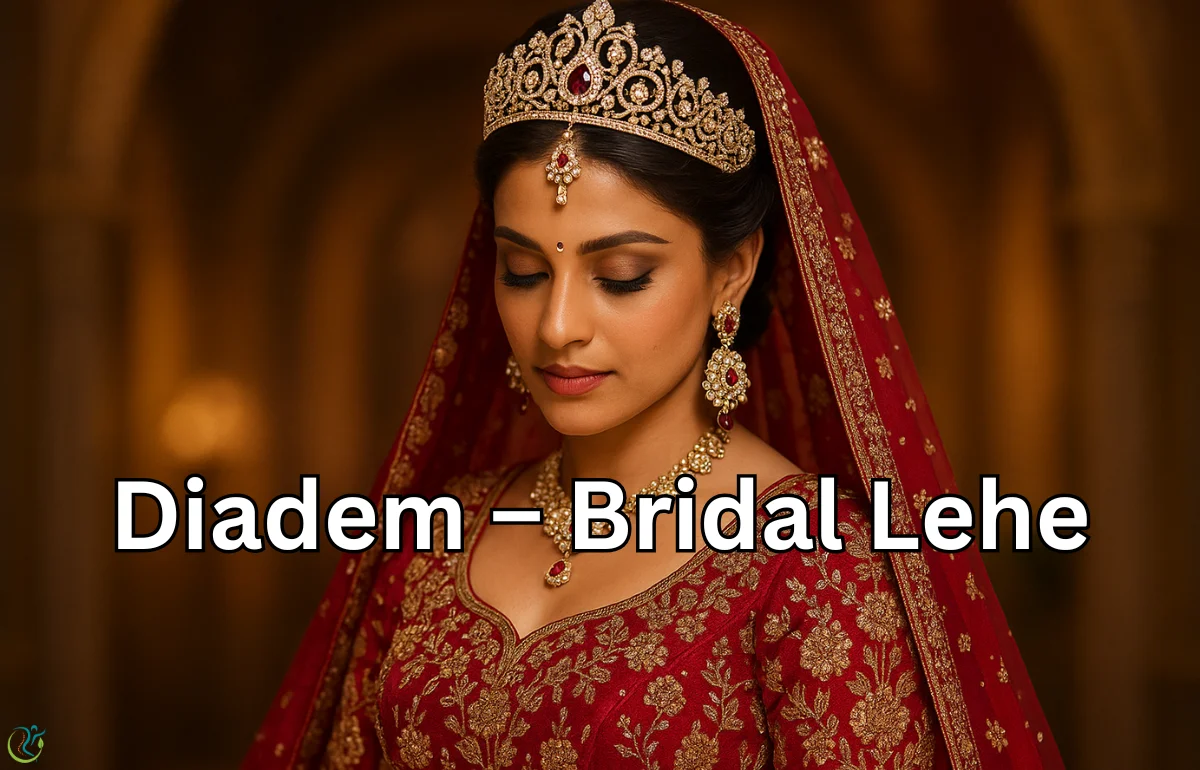
When it comes to weddings steeped in cultural richness and timeless style, few combinations rival the elegance of the Diadem – Bridal Lehe ensemble. This pairing is more than just a fashion statement—it’s a blend of heritage, symbolism, and personal identity. From ancient crowns to intricately woven lehengas, this fusion brings together regal charm and celebratory tradition in a breathtaking display of bridal grandeur.
Let’s explore how this pairing came to be, why it holds such deep cultural significance, and how today’s brides can harmonize these elements for a truly unforgettable look.
The Diadem: A Crown of Timeless Royalty
Royal Origins and Evolution
The diadem—essentially a jeweled headpiece—has its roots in some of the oldest civilizations in history. In ancient Egypt, it was worn by pharaohs and queens to signify divine authority. The Greeks and Romans followed suit, using ornate crowns to distinguish nobility and military triumph.
In modern times, diadems became synonymous with European royalty. From Queen Elizabeth II’s iconic tiaras to the elaborate headdresses seen in royal Indian weddings, diadems have retained their allure as status symbols and pieces of ceremonial beauty.
According to the Victoria and Albert Museum, “The tiara, or diadem, has long been associated with high social rank and was revived in the 18th century as a sign of aristocracy and affluence.” V&A Museum
The Bridal Lehe: A Fabric of Cultural Legacy
Historical Context and Modern Craftsmanship
The bridal lehenga, or lehe as it’s colloquially known in South Asia, has been a staple of royal Indian and Mughal attire for centuries. Traditionally worn by noblewomen, the lehenga evolved through regional influences and changing trends.
This three-piece outfit—comprising a flared skirt, blouse (choli), and a scarf (dupatta)—is often crafted from fabrics like silk, brocade, and velvet, richly embellished with zardozi, gota, or mirror work.
Bridal Significance
For brides, the lehenga is more than just attire. It represents family legacy, religious beliefs, and auspicious beginnings. Colors like red, maroon, and gold are particularly favored, symbolizing prosperity, love, and good fortune.
How to Style the Diadem – Bridal Lehe Combination
Achieving Harmony in Your Wedding Look
Pairing a diadem with a bridal lehe requires thoughtful coordination. It’s not just about placing a tiara on your head and donning a lehenga; it’s about weaving together aesthetic coherence, cultural depth, and personal expression.
Embellishment Balance
When your lehenga is heavily embroidered or encrusted with sequins, opt for a more minimalist diadem. Conversely, if your lehe is simple or monochromatic, a bold, gemstone-laden diadem can elevate the ensemble without clashing.
Color Coordination
Color harmony is crucial. For example:
A ruby-studded diadem complements a classic red lehenga.
Emeralds can enhance a green or gold outfit.
Diamonds or crystals suit pastel or ivory-toned lehengas.
Pro Tip: Match the metal base of your diadem with the embroidery tone of your lehenga—gold with gold, silver with cool-toned shades.
Face Shape and Hairstyle Matter
Your face shape plays a big role in selecting the right diadem:
This versatile face shape can carry off nearly every type of diadem with ease.
Round faces benefit from peaked or V-shaped diadems that elongate the face.
Heart-shaped faces look stunning with medium-height tiaras.
Hairstyles should also frame the diadem without overshadowing it. Popular styles include:
Classic low buns
Soft curls pinned to the side
Braided updos with side-swept strands
Metal and Gemstone Selection
Matching the diadem’s metal to your lehenga’s jewelry is essential. If your bridal set is in Kundan or Polki (traditional Indian jewelry forms), choose a diadem that mirrors that motif.
A Quick Comparison Table
| Styling Element | Considerations for Harmony |
|---|---|
| Embellishments | Simple diadem for heavy lehenga; bold for plain lehe |
| Color Palette | Match diadem gems to lehenga shades |
| Hairstyle | Must accommodate diadem placement without hiding it |
| Face Shape | Choose a diadem shape to complement facial features |
| Metal Choice | Coordinate metal with jewelry and lehenga embroidery |
Embracing Modern Interpretations
Today’s brides are not afraid to experiment. The traditional red-and-gold lehenga is being reimagined in hues like blush pink, ivory, emerald green, and even champagne. Fabrics are becoming lighter, silhouettes more fluid, and detailing more personalized.
Similarly, diadems are now being crafted with minimalist designs, colored stones, and non-traditional motifs like vines, stars, or ethnic patterns to suit diverse themes—be it a garden wedding or a palace-inspired venue.
Sustainable and Custom Designs
With growing interest in sustainable bridal fashion, many designers are using handwoven fabrics, ethical gemstones, and recyclable metals in bridal sets. Brides can now choose diadems and lehengas that align with their values as well as their aesthetics.
According to Harper’s Bazaar India, “The shift towards eco-conscious bridalwear is not a trend—it’s the future. Brides want meaning, not just sparkle.”
Conclusion: Crafting a Look That Tells Your Story
The Diadem – Bridal Lehe pairing is more than a fashion choice—it’s a reflection of who you are, where you come from, and what you dream of on your big day. Whether you’re drawn to the regal beauty of a gemstone-encrusted crown or the layered history stitched into a bridal lehenga, this combination lets you honor tradition while embracing your unique style.
As you plan your wedding day attire, think beyond the trends. Choose pieces that resonate with your personal story and cultural roots. And remember—when done right, the diadem and bridal lehe together can turn any bride into royalty.
Ready to create your perfect bridal look? Explore heritage-inspired collections from designers who specialize in custom bridal accessories and traditional couture—because your story deserves nothing less than timeless elegance.

Dear Readers, I’m Salman Khayam, the writer and founder of this blog, dedicated to bringing you valuable insights across a variety of topics. From dental and mental health to personal development, beauty, skincare, hair care, nutrition, fitness, and exercise, my goal is to empower and inspire through well-researched, engaging content.
